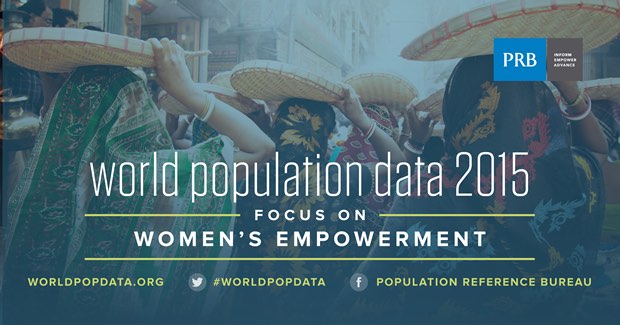
Lesson Plan: 2015 World Population Data Sheet
PRB’s World Population Data Sheet is an excellent reference and data analysis tool. Teachers are encouraged to have their students use the data sheet for a variety of topics and activities. The following are a series of short activities to provide access to the wealth of data on the world, regions, and individual countries.
This lesson plan uses PRB’s 2015 World Population Data Sheet
- Digital Visualization
- Graphics from the 2015 World Population Data Sheet
Also valuable is PRB’s Population Handbook 6th edition (2011).
These lessons may also be used with PRB’s online Data Center, a searchable database that includes all the data from the most recent PRB World Population Data Sheet. Data can be displayed as a map, chart, or table, and downloaded into Excel.
Grade Level: 6–12
Time Required: One class period for each activity.
Standards Addressed: Math and geography.
Vocabulary/Concepts: Population size, birth rate, death rate, infant mortality rate, total fertility rate, life expectancy, age distribution.
Objectives:
- Ask geographic questions about the population characteristics of a country.
- Acquire information about the key population characteristics of a country, by using the World Population Data Sheet.
- Organize population information about a country.
- Compare and contrast population characteristics of selected countries.
Materials:
- All activities: 2015 World Population Data Sheet (PDF: 2.5MB)
- Activity 2: County Profile Worksheet (PDF: 23KB)
- Activity 5: Country Outline Map (PDF: 94KB) Country outline maps for classroom use, including those for individual world regions, may be found online in a number of places.
Activity 1: The World Population Data Sheet at a Glance
Find answers to the following questions using the current World Population Data Sheet.
- What is the population of the world?
- Rank the ten countries with the largest population (from largest to smallest).
- Instead of absolute numbers, rates are often used to tell how frequently a population or demographic event is occurring — rates show how common an event is (often expressed as per 1,000 people). List the type of information on the data sheet reported by a rate.
- The death rate is the annual number of deaths per 1,000 population. Which country (or countries) has the highest death rate? Which country (or countries) has the lowest?
- The infant mortality rate measures the number of deaths each year to infants under one year of age per 1,000 live births. Which country (or countries) has the highest infant mortality rate and what is that rate? Which country (or countries) has the lowest and what is that rate?
- The total fertility rate (TFR) is the average number of children women would have if they maintained the current level of childbearing throughout their reproductive years. Which countries (or countries) share the highest TFR and what is it? Which country (or countries) has the lowest TFR. What is it?
- Which country (or countries) has the “youngest” population, that is, the highest proportion of population under age 15? Which country (or countries) has the “oldest” population, that is, the highest proportion of population over age 64?
- In which country (or countries) are people expected to live the longest? Which country (or countries) has the lowest life expectancy?
- In which African country (or countries) does the highest proportion of people live in urban areas? In Asia? In Latin America? In Europe? In Oceania?
- Gross national income in purchasing power parity per capita (GNI PPP) converts income into “international dollars” and indicates the amount of goods and services one could buy in the United States with a given amount of money. Which country (or countries) is the wealthiest in terms of GNI PPP? Which is the second wealthiest?
- A population projection is a computation of future changes in population numbers based on assumptions about future trends in fertility, mortality, and migration. Which categories on the data sheet are shown as projections?
- Rank the 10 countries with the largest projected populations for both 2023 and 2050 (from largest to the smallest). Which country’s (or countries’) population is projected to drop out of the top 10 by 2050? Which country (or countries) is projected to be added to the top 10? Look back to the rankings for the current year. What are the major shifts in this ranking from now to 2050?
- Rank the regions according to population size (from largest to the smallest).
- What proportion of the world’s people live in Africa? In Asia? In North America? In Latin America? In Europe? In Oceania? What are the projected proportions? Draw a bar chart showing the regional distributions of the world’s population for this year, 2030 and 2050.
- What proportion of the world’s people live in less developed countries (LDCs) in the current year? In more developed countries (MDCs)? What proportion of the world’s people is projected to live in LDCs in 2030? In 2050? What proportion is projected to live in MDCs in 2030? In 2050?
Activity 2: Profiling a Country
The purpose of this activity is to introduce students to the demographic indicators listed on the Data Sheet by providing them with a tool to organize population information about a country. As students study different countries they can accumulate country profiles in their notebook. Students will need to use the World Population Data Sheet and the Country Profile Worksheet.
Note: The rate of natural increase is the rate at which a population is increasing (or decreasing) in a given year due to a surplus (or deficit) of births over deaths, expressed as a percentage of the base population. It is calculated by subtracting death rates from birth rates and then dividing by 10. This rate does not include the effects of immigration or emigration.
- Display the Country Profile Worksheet. Distribute blank copies to students. Complete the profile of the United States, defining the indicators as they are mapped out on the worksheet. After completing the “country comparison blocks,” discuss.
- Have students place a copy of the U.S. profiles in their notebooks. Have students complete a new profile each time they start a unit on a new country. Before they do the profile of the new country, students should develop hypotheses about the population characteristics of the country and use the mapping activity to test their hypotheses. They should compare the profile of each new country with the profile of the United States.
- As students learn more about the country, they can add other information from the Data Sheet (or other sources) to their profiles.
This lesson was adapted from a lesson developed by Jane Moriarty of the Michigan Geographic Alliance.
Activity 3: Mapping the Data
Mapping data is often a good method for analysis. Most of the demographic characteristics on the World Population Data Sheet lend themselves to mapping. A map that uses color to represent quantitative data is called a choropleth map. Areas are distinguished from one another using different colors or different shades of the same color based on the values they represent. Brighter colors or dark shades of the same color indicate greater values and dimmer colors or lighter shades indicate lesser values.
Choose one of the following demographic variables using the World Population Data Sheet and map the world or regional distribution of that indicator on a world or regional country outline map:
Infant Mortality Birth Rate Death Rate
Total Fertility Rate Percent 65 and Over Percent Under Age 15
Per Capita GNI PPP Life Expectancy
Interpret the map
After the map has been drawn, consider the following to guide interpretation:
- Describe the patterns observed on the map.
- What accounts for the variation?
- Discuss the factors that could lead to the range of outcomes within this distribution.
Draw another map
Draw another map to examine the relationships that may exist between two variables or compare results with another student who has mapped a different variable. Possible pairs of variables to compare:
- Infant Mortality — Life Expectancy
- Death Rate — Percent of Population Under Age 15
- Birth Rate — Percent of Population 65+
- Infant Mortality — Per Capita GNI PPP
Answer the following:
- Does there appear to be a relationship between the two variables? If so, is the relationship positive of negative? For example, are the countries with the highest rates of one variable the same countries with the highest rates of the other variable? If so, then the relationship is positive. If the countries with the highest rate of one variable also have the lowest rates in another, then the relationship is negative.
- Discuss whether or not the factors that contribute to the patterns in one variable affect the patterns in another.
This activity was adapted from exercises submitted by Eugene J. Kinerney of the University of the District of Columbia and Basheer K. Nijim of the University of Northern Iowa. The lesson plan was updated in 2015 by Paola Scommegna, PRB.

 ">
">
 ">
">
 ">
">